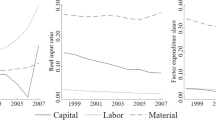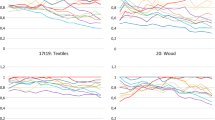Abstract
The paper by Ji and Wang (J Technol Transf, 2013) calls new attention on the analysis of the effects of the direction of technological change. The aim of this paper is to better articulate and test the theoretical arguments that the direction of technological changes has specific effects on the efficiency of the production process and to study the incentives and the processes that lead to its introduction. The decomposition of total factor productivity growth into the bias and the shift effects enables to articulate the hypothesis that the types of technological change whether more neutral or more biased reflect the variety of the innovation processes at work. The evidence of a large sample of European regions tests the hypothesis that regional innovations systems with a strong science base are better able to introduce neutral technological changes while regional innovation systems that rely more upon learning processes and tacit knowledge favor the introduction of directed technologies a form of meta-substitution that aims at exploiting the opportunities provided by the most intensive use of locally abundant factors.


Similar content being viewed by others
Notes
Actually the bottom line of Ji and Wang is that the methodology proposed in Antonelli and Quatraro (2010) is wrong because the original was wrong. However, Solow’s paper is focused on neutral technological change, as this seemed to be appropriate for analyzing the US evidence. It is a matter of fact that the methodology developed by Solow allows to capture only the shift in the production factor.
Actually Ji and Wang propose an index to capture both the shift and the bias effect which is exactly the Total Technology Productivity (TTP) index proposed by Bernard and Jones (1996). The idea is modify the Solow’s index by freezing the levels of capital and labour, so as to have the very same values for all regions/countries which remain constant over time. However this index allows to disentangling the exact contribution of factor changes, and not the contribution of changes of factors’ shares. Moreover, besides the drawbacks already emphasized by Bernard and Jones, it has also undesirable feature to be very sensitive to changes in the conditions of labor markets.
We acknowledge that the use of administrative regions to investigate represents only an approximation of the local dynamics underpinning economic activities. Indeed administrative borders are arbitrary, and therefore might not be representative of the spontaneous emergence of local interactions. It would be much better to investigate these dynamics by focusing on local systems of innovation. However, it is impossible to find out data at such a level of aggregation. Moreover, the identification of local systems involve the choice of indicators and threshold values according to which one can decide whether to unbundle or not local institutions. This choice is in turn arbitrary, and therefore it would not solve the problem, but it would only reproduce the issue at a different level. Thus we think that despite the unavoidable approximation, our analysis may provide useful information on the dynamics under scrutiny.
The differences with the methodology by Ji and Wang (2013) are clear. Actually their index is sensitive to changes in factor prices even if these did not engender any creative reaction aimed at introducing a biased technology. In order Jin and Wang’s methodology to hold, factor’s costs and firms’ budget must be constant. In this sense, while our methodology allows to assessing the extent to which the directionality of biased technological change matched local factor endowments, Ji and Wang’s index allows to evaluating the extent to which the change in factors endowments matched the locally available technology. See Feder (2014) for an illustration of such drawbacks.
The choice of the time span is shaped by data constraints, which do not allow us to calculate elasticities at the regional level before the year 1995, when Eurostat introduced the standard accounting procedure (ESA). Ten years can be regarded is a sufficient time spam to allow to appreciating the emergence of structural shifts.
References
Acemoglu, D. (1998). Why do new technologies complement skills? Directed technical change and wage inequality. Quarterly Journal of Economics, 113, 1055–1089.
Acemoglu, D. K. (2002). Directed technical change. Review of Economic Studies, 69, 781–809.
Acemoglu, D. (2003). Labor- and capital-augmenting technical change. Journal of European Economic Association, 1, 1–37.
Acemoglu, D. K. (2010). When does labor scarcity encourage innovation? Journal of Political Economy, 118, 1037–1078.
Acs, Z. J., Anselin, L., & Varga, A., (2002). Patents and innovation counts as measures of regional production of new knowledge. Research Policy, 31, 1069–1085.
Alessandrini, M., & Batuo, M. E. (2010). The trade specialisation of SANE: Evidence from manufacturing industries. European Journal of Comparative Economics, 7, 145–178.
Alessandrini, M., Fattouh, B., & Scaramozzino, P. (2007). The changing pattern of foreign trade specialisation in Indian manufacturing. Oxford Review of Economic Policy, 23(2), 270–291.
Antonelli, C. (1999). The microdynamics of technological change. London: Routledge.
Antonelli, C. (2002). Innovation and structural change. Economie Appliquèe, 55, 85–120.
Antonelli, C. (2003). The economics of innovation new technologies and structural change. London: Routledge.
Antonelli, C. (2006). Localized technological change and factor markets: Constraints and inducements to innovation. Structural Change and Economic Dynamics, 17, 224–247.
Antonelli, C. (2008). Localized technological change. London: Towards the economics of complexity.
Antonelli, C. (2012). Technological congruence and productivity growth. In M. Andersson, B. Johansson, C. Karlsson, & H. Lööf (Eds.), Innovation and growth—From R&D strategies of innovating firms to economy-wide technological change (pp. 209–232). Oxford: Oxford University Press.
Antonelli, C., & Quatraro, F. (2010). The effects of biased technological change on total factor productivity. Empirical evidence from a sample of OECD countries. Journal of Technology Transfer, 35, 361–383.
Antonelli, C., & Quatraro, F. (2013). Localized technological change and efficiency wages: The evidence across European regions. Regional Studies, 47, 1686–1700.
Arellano, M., & Bond, S. R. (1991). Some tests of specification for panel data: Monte Carlo evidence and an application to employment equations. Review of Economic Studies, 58, 277–297.
Arellano, M., & Bover, O. (1995). Another look and the instrumental-variable estimation of error-components models. Journal of Econometrics, 68, 29–52.
Bailey, A., Irz, X., & Balcombe, K. (2004). Measuring productivity growth when technological change is biased. A new index and an application to UK agriculture. Agricultural Economics, 31, 285–295.
Bernard, A. B., & Jones, C. J. (1996). Comparing apples to oranges: Productivity convergence and measurement across industries and countries. American Economic Review, 86(5), 1216–1238.
Blundell, R. W., & Bond, S. R. (1998). Initial conditions and moment restrictions in dynamic panel data models. Journal of Econometrics, 87, 115–143.
Caminati, M. (2006). Knowledge growth, complexity and the returns to R&D. Journal of Evolutionary Economics, 16, 207–229.
Cantwell, J. (1989). Technological innovation and multinational corporations. Oxford: Blackwell Publisher.
Caselli, F., & Coleman, W. J, I. I. (2006). The world technology frontier. American Economic Review, 96(3), 499–522.
Chiappini, R. (2013). Persistence vs. mobility in industrial and technological specialisations: Evidence from 11 Euro area countries. Journal of Evolutionary Economics. doi:10.1007/s00191-013-0331-7.
Feder, C. (2014). Biased technological change: A contribution to the debate, LEI&BRICK Working Paper 1/2014, Department of Economics, University of Torino.
Fleming, L., & Sorenson, O. (2001). Technology as a complex adaptive system: Evidence from patent data. Research Policy, 30, 1019–1039.
Foray, D. (2004). The economics of knowledge. Cambridge: MIT Press.
Griliches, Z. (1990). Patent statistics as economic indicators: A survey. Journal of Economic Literature, 28, 1661–1707.
Hall, R. E., & Jones, C. I. (1999). Why do some countries produce so much more output per worker than others? Quarterly Journal of Economics, 114, 83–116.
Hall, B. H., Griliches, Z., & Hausman, J. A. (1986). Patents and R and D: Is there a lag? International Economic Review, 27, 265–283.
Jerzmanowski, M. (2007). Total factor productivity differences: Appropriate technology vs. efficiency. European Economic Review, 51, 2080–2110.
Ji, Y., & Wang, Y. (2013). Some comments on Antonelli’s paper of measuring effect of biased technology on TFP. Journal of Technology Transfer. doi:10.1007/s10961-013-9310-2.
Jorgenson, D. W. (1995). Productivity volume 1: Post-war US economic growth. Cambridge, MA: MIT Press.
Link, A. N. (1987). Technological change and productivity growth. London: Harwood Academic Publishers.
Mancusi, M. L. (2001). Technological specialisation in industrial countries. Review of World Economics (Weltwirtschaftliches Archiv), 137(4), 593–621.
Mancusi, M. L. (2012). National externalities and path-dependence in technological change: An empirical test. Economica, 79(314), 329–349.
March, J. C. (1991). Exploration and exploitation in organizational learning. Organization Science, 2, 71–87.
Nesta, L. (2008). Knowledge and productivity in the world’s largest manufacturing corporations. Journal of Economic Behavior and Organization, 67, 886–902.
Nesta, L., & Saviotti, P. (2005). Coherence of the knowledge base and the firm’s innovative performance: evidence from the U.S. pharmaceutical industry. Journal of Industrial Economics, 53, 123–142.
Organisation for Economic Co-operation and Development (OECD). (2001). Measuring productivity. Measurement of aggregate and industry-level productivity growth. Paris: OECD.
Pavitt, K. (1985). Patent statistics as indicators of innovative activities: Possibilities and problems. Scientometrics, 7, 77–99.
Pavitt, K. (1989). International patterns of technological accumulation, In N. Hood, Vahlne J.-E. (Eds.) Strategies in global competition (pp 126–151), Croom Helm Publisher: London.
Piva, M., Santarelli, E., & Vivarelli, M. (2006). Technological and organizational changes as determinants of the skill bias: Evidence from the Italian machinery industry. Managerial and Decision Economics, 27, 63–73.
Quah, D. T. (1993). Empirical cross-section dynamics in economic growth. European Economic Review, 37(2–3), 426–434.
Quah, D. T. (1996). Empirics for economic growth and convergence. European Economic Review, 40(6), 1353–1375.
Quah, D. T. (1997). Empirics for economic growth and distribution: Stratification, polarization and convergence clubs. Journal of Economic Growth, 2(1), 27–59.
Quatraro, F. (2010). Knowledge coherence, variety and productivity growth: Manufacturing evidence from Italian regions. Research Policy, 39, 1289–1302.
Redding, S. (2002). Specialisation dynamics. Journal of International Economics, 58(2), 299–334.
Ruttan, V. W. (1997). Induced innovation evolutionary theory and path dependence: Sources of technical change. Economic Journal, 107, 1520–1529.
Ruttan, V. W. (2001). Technology growth and development. An induced innovation perspective. Oxford: Oxford University Press.
Salter, W. E. G. (1960). Productivity and technical change. Cambridge: Cambridge University Press.
Saviotti, P. P. (2007). On the dynamics of generation and utilisation of knowledge: The local character of knowledge. Structural Change and Economic Dynamics, 18, 387–408.
Scherer, F. M. (1984). Innovation and growth: Schumpeterian perspectives. Cambridge, MA: MIT Press.
Shorrocks, A. (1978). The measurement of mobility. Econometrica, 46(5), 1013–1024.
Solow, R. M. (1957). Technical change and the aggregate production function. Review of Economics and Statistics, 39, 312–320.
Stoneman, P. L. (2010). Soft innovation: Economics, product aesthetics and the creative industries. Oxford: Oxford University Press.
Uchida, Y., & Cook, P. (2005). The transformation of competitive advantage in East Asia: An analysis of technological and trade specialisation. World Development, 33(5), 701–728.
Vaona, A., & Pianta, M. (2008). Firm size and innovation in European manufacturing. Small Business Economics, 31, 283–299.
Weitzman, M. L. (1998). Recombinant growth. Quarterly Journal of Economics, 113, 331–360.
Zaghini, A. (2005). Evolution of trade patterns in the new EU member States. Economics of Transition, 13(4), 629–658.
Acknowledgments
This paper contributes the research project ‘Policy Incentives for the Creation of Knowledge: Methods and Evidence’ (PICK-ME), funded by the European Union D.G. We wish to thank Cristophe Feder for insightful discussions on the topic, and the editor Al Link for his detailed comments.
Author information
Authors and Affiliations
Corresponding author
Rights and permissions
About this article
Cite this article
Antonelli, C., Quatraro, F. The effects of biased technological changes on total factor productivity: a rejoinder and new empirical evidence. J Technol Transf 39, 281–299 (2014). https://doi.org/10.1007/s10961-013-9328-5
Published:
Issue Date:
DOI: https://doi.org/10.1007/s10961-013-9328-5




